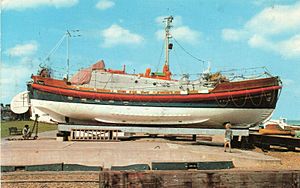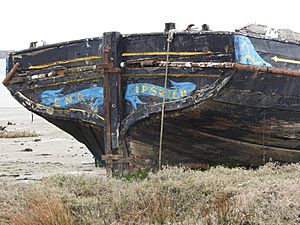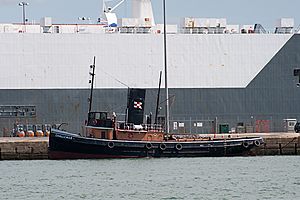Little Ships of Dunkirk facts for kids
The Little Ships of Dunkirk were about 850 private boats. They sailed from Ramsgate in England to Dunkirk in northern France. This happened between May 26 and June 4, 1940. These boats were part of Operation Dynamo. They helped rescue over 336,000 British, French, and other Allied soldiers. These soldiers were trapped on the beaches at Dunkirk during World War II.
Contents
The Big Rescue at Dunkirk
The soldiers were cut off by the German army. They were stuck on the beaches of Dunkirk. The British Prime Minister, Winston Churchill, thought this was a huge military defeat. It looked like Britain might lose the war. Most of the British army was trapped. This left Britain open to attack by Germany.
Large British warships, like destroyers, could not get close to the beaches. The water was too shallow. Soldiers had to wade out to the boats. Many waited for hours in water up to their shoulders.
On May 27, the British Ministry of Shipping called boat builders. They asked for all boats with "shallow draft" (meaning they didn't need deep water). These boats could get close to the beaches. They looked for pleasure boats, yachts, and launches. Many were on the River Thames and along the coasts. Some owners let their boats be used. Others were taken by the government quickly.
The boats were checked to make sure they were safe. They were filled with fuel. Then, they were taken to Ramsgate to sail for Dunkirk. Royal Navy officers, sailors, and experienced volunteers crewed them. Very few owners sailed their own boats, except for some fishermen.
When they reached France, some boats acted like shuttles. They moved soldiers from the beaches to the bigger destroyers. Other boats carried hundreds of soldiers back to Ramsgate, England. The Royal Air Force protected them from German air attacks.
The term "Little Ship" means any boat that was privately owned. This includes barges, fishing boats, and pleasure steamers. It also includes some old military boats now owned by people, and old lifeboats.
Famous Little Ships
- MV Royal Daffodil (1939) – This ship was already moving troops. It was taken from the General Steam Navigation Company. It rescued 7,461 soldiers from Dunkirk in five trips. This was the most rescued by one passenger ship.
- Medway Queen – This paddle steamer made the most trips, seven in total. It rescued 7,000 men. People called her the "Heroine of Dunkirk." Today, you can visit her at the Gillingham Pier in Kent.
- Massey Shaw – This London fireboat first went to Dunkirk to fight fires. It made three trips across the channel. It rescued over 500 troops.
- Sundowner – This motor yacht belonged to Charles Lightoller. He was the second officer of the Titanic. The navy took his boat on May 30. Lightoller insisted he would sail her himself. He went with his son and a Sea Scout. They carried 127 soldiers back to Ramsgate. The boat is now a museum ship at the Ramsgate Maritime Museum.
- Bluebird of Chelsea – This yacht made two trips to Kent. It carried hundreds of men.
- Tamzine – This fishing boat was less than 15 feet (4.6 m) long. It was the smallest boat to take part in the rescue. It is now kept at the Imperial War Museum.
Lifeboats from the RNLI
Many lifeboats from the Royal National Lifeboat Institution (RNLI) helped at Dunkirk. Here are a few examples:
- Abdy Beauclerk (ON 751) – From Aldeburgh Lifeboat Station.
- Cecil and Lilian Philpott (ON 730) – From Newhaven. It rescued 51 soldiers. It got stuck on the beach for hours but kept rescuing people the next day.
- Charles Dibdin (Civil Service No. 2) (ON 762) – From Walmer.
- Edward Dresden (ON 707) – From Clacton-on-Sea. It was one of the few boats sailed to Dunkirk by its own crew.
- Jane Holland (ON 673) – From Hastings. It was damaged by a torpedo boat and machine-gun fire. It was later found, repaired, and returned to service.
- Lord Southborough (Civil Service No. 1) (ON 688) – From Margate. It rescued over 500 men and took them to a destroyer.
- Prudential (ON 697) – From Ramsgate. Its own crew sailed it to Dunkirk. They collected 2,800 men from the beaches.
- Viscountess Wakefield (ON 783) – From Hythe. It was the only lifeboat to sink during the operation.
Thames Sailing Barges
Thirteen Thames sailing barges crossed the channel. Six of them were from R & W Paul Ltd.
- Ena – Its crew was told to leave it at Dunkirk. But then, some soldiers refloated it and sailed it back to Ramsgate by themselves.
- Greta – Built in 1892, it is thought to be the oldest Little Ship still active today.
Dutch Coasters
Thirty-nine Dutch coasters (small trading ships) had escaped from the Netherlands when Germany took over in May 1940. They were asked to help. These ships could get very close to the beaches because they had flat bottoms. They rescued 22,698 men.
The MV Rian was a 35-metre (115 ft) ship. It saved 2,542 men between May 28 and 31, 1940. This was the most men saved by any Dutch coaster. Other Dutch coasters that saved over 1,000 men each were:
- MV Hondsrug: 1,455 men
- MV Patria: 1,400 men
- MV Hilda: 1,200 men
- MV Doggersbank: 1,200 men
- MV Horst: 1,150 men
- MV Twente: 1,139 men
- MV Friso: 1,002 men
Seven of these Dutch ships were lost during the Dunkirk rescue.
Belgian Ships
The Belgian Army had surrendered to the Germans on May 28. Many ships from the Belgian fishing fleet and small navy helped in Operation Dynamo. In total, 65 Belgian ships took part. This included 54 fishing boats, four navy units, four tugs, and two patrol vessels. The Belgian fishing fleet alone carried 4,300 British and French soldiers to England.
Some Belgian ships that helped were Patrol vessel A5, Z25 De Ruyter, and Belgian ship H75.
Amazing Results
In just nine days, 192,226 British and 139,000 French soldiers were rescued. That's more than 331,000 people! The 700 Little Ships and about 220 warships made this possible. This rescue turned a military disaster into a story of bravery. It greatly boosted the spirits of the British people.
On June 4, 1940, Winston Churchill spoke to the British Parliament. He described the success of the rescue. This is when he gave his famous "we shall fight on the beaches" speech:
We shall go on to the end, we shall fight in France, we shall fight on the seas and oceans, we shall fight with growing confidence and growing strength in the air, we shall defend our Island, whatever the cost may be, we shall fight on the beaches, we shall fight on the landing grounds, we shall fight in the fields and in the streets, we shall fight in the hills; we shall never surrender ...
What We Remember Today
The phrase "Dunkirk spirit" is still used today. It describes courage and working together when things are tough.
The Association of Dunkirk Little Ships (ADLS) was started in 1965. It is for owners of these special boats. Every five years, the Association organizes a trip for the Little Ships back to Dunkirk. The Royal Navy escorts them. Their flag is the St George's Cross with the Dunkirk coat of arms. It is known as the Dunkirk Jack.
The Dunkirk Little Ships Restoration Trust is a charity. It was set up in 1993 to save and fix up Dunkirk Little Ships. Their collection includes the steam tug ST Challenge. This vessel is part of the National Historic Fleet.
At least twelve real Little Ships were used in the 2017 movie Dunkirk.
One of the Little Ships, the Red Funnel paddle steamer PS Princess Elizabeth, is now owned by the City of Dunkirk. It is permanently docked in the harbor as a floating meeting center.
See also
- Battle of France
- Dunkirk evacuation
- National Historic Ships
- List of ships involved in the Dunkirk evacuation
- Little Ship Club
- The Snow Goose: A Story of Dunkirk novella by Paul Gallico





